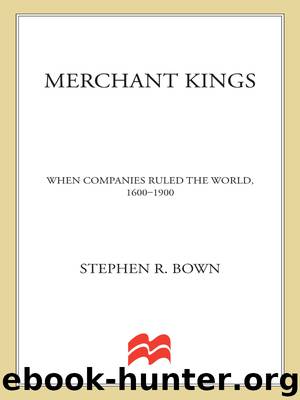Merchant Kings: When Companies Ruled the World, 1600-1900 by Stephen R. Bown

Author:Stephen R. Bown [Bown, Stephen R.]
Language: eng
Format: azw3
Publisher: St. Martin's Press
Published: 2010-12-07T05:00:00+00:00
· 2 ·
Russian traders and private explorers had been sailing the Pacific east to the distant shores of North America for about fifty years, ever since the epic voyage of Vitus Bering known as the second Kamchatka expedition. This expedition had been inspired by the progressive reforms of Peter the Great and continued by his widow, Empress Anna Ivanovna.
The second Kamchatka expedition was one of the most ambitious scientific and exploratory expeditions ever undertaken. Based on Bering’s sober proposal to follow up on the inconclusive results of his first voyage in search of America a decade earlier, the second expedition was designed to show Europe the grandeur and sophistication of Russia. By the time Bering saw his final instructions in 1731, they had swollen to such grandiose proportions that he scarcely recognized them. He would be at the head of a virtual army of exploration: a few thousand scientists, secretaries, students, interpreters, artists, surveyors, naval officers, mariners, soldiers and skilled labourers, all of whom had to be brought to the eastern coast of Russia across eight thousand kilometres of roadless forests, swamps and tundra, along with tools, iron, canvas, food, books and scientific implements.
Once he arrived in Kamchatka, Bering was supposed to build two ships and sail east to America, charting the North American Pacific coastline as far south as California, in addition to charting the coasts of Kamchatka and the Arctic Ocean and establishing astronomical positions throughout Siberia. Concurrently, he was to build another three ships and survey the Kuril Islands, Japan and other areas of eastern Asia. These were his most reasonable and practical instructions. His orders also called for him to populate Okhotsk with Russian citizens, introduce cattle raising on the Pacific coast, found elementary and nautical schools in the distant outpost, construct a dockyard for deepwater ships, and establish iron mines and ironworks for smelting ore. Not surprisingly, despite Bering’s Herculean efforts, these tasks would not be completed for generations.
On June 5, 1741, Bering’s two ships slid out of the makeshift dockyards at Petropavlovsk, lurched into the grey, choppy waters and hoisted sails. As the St. Paul pushed east through the fog, Bering spent much of his time laid up below deck with an energy-sapping illness. The officers thus began running the ship without consulting him or informing him of their decisions. For almost a month, it was a dreary and uncertain voyage; the voyagers saw nothing but sky and sea until July 16. Then, their first view of America: a mighty, snow-dusted spire shrouded in fog. It towered over a vast range of smaller mountains, snug against the coast as far as the eye could see, with endless forests of green emerging into view through the mist. It was St. Elias Day, and they named the peak accordingly. The mountains, the naturalist Georg Steller observed, “were so lofty that we could see them quite plainly at sea at a distance of sixteen Dutch miles…I can not recall having seen higher mountains anywhere in Siberia and Kamchatka.
Download
This site does not store any files on its server. We only index and link to content provided by other sites. Please contact the content providers to delete copyright contents if any and email us, we'll remove relevant links or contents immediately.
The Book of Dreams (Saxon Series) by Severin Tim(32937)
Who'd Have Thought by G Benson(16162)
Always and Forever, Lara Jean by Jenny Han(14498)
Bull's Eye Sniper Chronicles Collection (The Second Cycle of the Betrayed Series) by McCray Carolyn(11966)
Firetrap: The Soul Scorchers MC (The Scorched Souls Serial-series Book 1) by Riley C.L(10945)
Warriors (9781101621189) by Young Tom(10342)
Oathbringer by Brandon Sanderson(9215)
Fourth Wing by Rebecca Yarros(9205)
The City of Brass by S. A. Chakraborty(8529)
Thirteen Reasons Why by Jay Asher(8472)
Red Rising by Pierce Brown(8288)
Storm and Silence by Robert Thier(6505)
The Thirst by Nesbo Jo(6452)
Shadows Of The Apt [01] - Empire in Black and Gold by Adrian Tchaikovsky(6427)
Pandemic (The Extinction Files Book 1) by A.G. Riddle(6204)
Assassin’s Fate by Robin Hobb(5867)
Six Wakes by Mur Lafferty(5847)
The Demon Crown: A Sigma Force Novel by James Rollins(5599)
The Fall of Dragons by Miles Cameron(5380)
